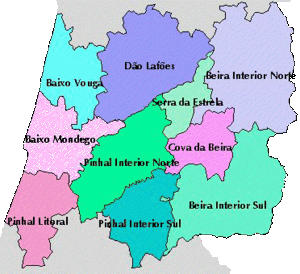- Dão DOC
-
Dão (wine region) 
Official name Dão-Lafões Type Denominação de Origem Controlada Country Portugal Part of Centro, Portugal Climate region Temperate Soil conditions Sandy on top of Granite Grapes produced Touriga Nacional, Tinta Roriz, Jaen, Alfrocheiro Preto and Encruzado Wine produced Dão wine Dão is a Portuguese wine region situated in the Região Demarcada do Dão with the Dão-Lafões sub region of the Centro, Portugal. It is one of the oldest established wine regions in Portugal. Dão wine is produced in a mountainous region with a temperate climate, in the area of the Rio Mondego and Dão rivers in the north central region of Portugal.[1] The region became a Denominação de Origem Controlada (DOC) appellation in 1990. The Dão region is the origin of the Touriga Nacional vine that is the principal component of Port wine.[2]
Contents
Climate and geography
The wine region is located primarily on a plateau that is sheltered on three sides by the granite mountain ranges of Serra da Estrela, Serra do Caramulo and Serra da Nave. This helps the area maintain its temperate climate away from the affects of the nearby Atlantic Ocean. The region experiences abundant rainfall in the winter months and long, warm dry summers leading up to harvest. The region's vineyards are planted on sandy well-drained soil on top of granite rock..[2]
History
The Dão was first officially recognized as a Região Demarcada in 1908. In the 1940s, to improve the quality of the wine from the region and promote some sort of national identity, the government of Prime Minister António de Oliveira Salazar instituted new regulation establishing the mandatory use of co-operatives in the region. These co-operatives would have exclusive privilege to the grapes grown in the region and where charged with making the wine that would be sold to private merchants. Despite its intent, the regulations had an adverse affect on the Dão wine region by promoting stagnation due to lack of competition with some co-operative firms releasing inferior quality wine and even practice un-hygienic winemaking. In 1979, Portugal's application to the European Union prompted authorities to overturn these rules passed on the EU discouragement of monopolistic practices in the wine industry.[2]
Viticulture and wines
The area is home to several dozen varieties of indigenous grapes with the majority of wine production being made from the Touriga Nacional, Tinta Roriz, Jaen, Alfrocheiro Preto and Encruzado. 80% of the region's production is in red wines with DOC regulations stipulating that at least 20% of the production must be from Touriga Nacional.[2] Some of the top reserve wine may carry the designation Dão nobre (meaning noble Dão).[3] Another reserve designation Garrafeira requires wines to be 0.5% higher in alcohol content then the 12.5% minimum and to spend at least 2 years in aging in oak. The maximum yield for red wine grapes is 70 hl/ha.[4]
The red wines tend to be very tannic due to prolong periods of maceration during winemaking. Many producers make liberal use of French and Portuguese oak. The style has been improving with some producers concentrating on make more fruit-forward styles with smoother tannins.[1] Historically the white wines were known for being over oxidized and full bodied but more modern winemaking has been producing white wines that are fresh, fruity and fragrant. The Encruzado is the principal grape of the area's whites with some blend of Malvasia Fina and Bical.[2]Garrafeira white wines require at least 0.5% more alcohol by volume then the 11.5% DOC minimum and at least 6 months aging in oak. The maximum allowable yields for white wine grapes is 80 hl/ha.[4]
Subregions
There are seven subregions within Dão which may be indicated on labels together with Dão:[5]
- Alva
- Besteiros
- Castendo
- Serra da Estrela
- Silgueiros
- Terras de Azurara
- Terras de Senhorim
See also
References
- ^ a b H. Johnson & J. Robinson The World Atlas of Wine pg 204-205 Mitchell Beazley Publishing 2005 ISBN 1840003324
- ^ a b c d e J. Robinson (ed) "The Oxford Companion to Wine" Third Edition pg 223 Oxford University Press 2006 ISBN 0198609906
- ^ K. MacNeil The Wine Bible pg 508 Workman Publishing 2001 ISBN 1563054345
- ^ a b P. Saunders Wine Label Language pg 250 Firefly Books 2004 ISBN 1552977200
- ^ Official Journal of the European Union C 187/1, 8.8.2009: List of quality wines produced in specified regions (reflects situation as of July 31, 2009)
External links
Categories:- Wine regions of Portugal
- Portuguese products with protected designation of origin
Wikimedia Foundation. 2010.

